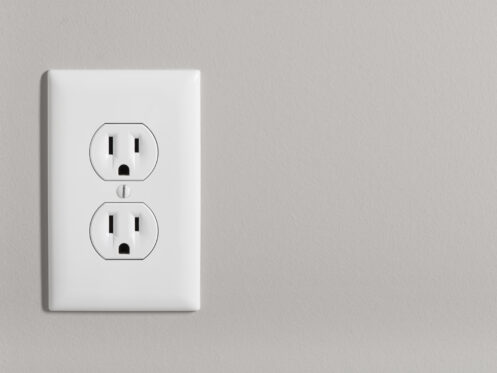Smart electrical outlets or plugs have among the highest adoption rates of all home automation technologies. These devices are relatively inexpensive and simple to install, and they can result in significant energy savings quickly. Smart devices are electronic devices that can perform some level of computing and connect to other smart devices to share and interact. A smart plug or outlet connects to your home network and can enable and disable appliances connected to it, track energy consumption and much more. Smart plugs not only work with other smart devices but non-smart appliances too, such as lamps, coffee makers and smartphone charges.
Reduce Vampire Drain
Standby power is the process through which appliances continue to draw electricity even when they are turned off. This type of usage is also referred to as vampire drain, phantom load and electrical leakage. This wasteful consumption became so problematic that the U.S. and most countries throughout the world established regulatory limits. Still, vampire drain accounts for 10% of total energy consumption for the average American household. That easily adds up to about $200 annually.
For example, when your TV is connected to a smart electrical outlet, and you turn it off, that television is no longer draining any power at all — vampire drain is gone. This is also true of other appliances, like coffee makers, microwaves and phone chargers. If you combine appliances onto a single smart plug or power strip, you can easily cover the cost of that investment in a single year. From there on out, eliminated standby power is just pure savings.
Remote Access
Another way that you can save with smart electrical outlets is through remote access. Forget to turn the lights out? Access all the lamps connected to a smart plug through your smartphone or tablet via the internet. You can also invest in smart switches to control integrated lighting and ceiling fans. Most home automation systems allow you to give each smart outlet a unique label. Simple names, like “living room table lamps” and “master bedroom end table lamps,” make it easy to find the plugs you need to access.
Access Via a Virtual Home Assistant Device
In the introduction, we mentioned that smart plugs have among the highest adoption rates when it comes to home automation. The device with the highest is the virtual home assistant. Popular examples include Alexa, Google Home and Siri. You can purchase smart plugs with voice capabilities, but that’s generally an unnecessary feature when you have a VHA. A VHA also makes it easy to complete tasks in a batch. You could say, “Alexa, turn off all the plugs in the kitchen.”
Scheduling
Scheduling is a powerful way to save as well. Set your smart plugs to enable and disable at particular times of the day. Better yet, use a VHA to set up schedules for entire groups of plugs. You could have Siri turn off all the unnecessary plugs in the home after the time when everyone is out the door for work and school. Some home automation systems support programming and machine learning as well. The system can identify areas of wasteful electricity usage and make recommendations to schedule better or update the schedule automatically.
Take Advantage of Off-Peak Energy Costs
In many areas of the U.S., energy costs vary based on the time of day and even the season. Costs are lower during off-peak hours. If you consistently run an appliance during this off-peak period, the savings can be considerable. One of the most common examples is a dishwasher. You would fill it after dinnertime but don’t have the automation system start it until after your peak hours end. Another example of how homeowners are saving through non-peak usage is EV charging. Topping your EV off only when the electricity rates are lowest will make a significant difference over the life of the vehicle.
Timers
Most smart electrical outlets provide timers as well. This is convenient because not everything can be scheduled. You can save a lot by having your system automatically turn off lamps or a coffee maker after an hour. It is also possible to receive alerts through your phone. If you’re sleeping in front of the TV and don’t see the alert, everything will turn off. If you’re still watching, swipe or voice cancel, and the timer will renew.
If This, Then That
Most modern smart electrical outlets also support ‘If This, Then That.’ This concept is abbreviated IFTTT, which, when you say it as an anagram, rhymes with the word ‘gift.’ This is one of the core concepts in computer programming: If this occurs, then do that. Devices that are often enabled and disabled conditionally, include fans, dehumidifiers and humidifiers and air purification systems. You can also chain outlets. For instance, whenever the TV outlet is disabled, the outlets for other home entertainment devices are disabled as well.
Track Energy Consumption
Another feature that most modern smart plugs have is energy tracking. These units can track overall usage as well as usage per connection. Some even let you connect other devices via USB to view the usage locally. Smart plugs will also report this information to the home automation system. That system can then provide you breakdowns per outlet, per outlet group and for the entire home. This is a great way to identify areas where you are being wasteful. It can also help you identify electrical issues with an appliance or even your home’s entire electrical system.
Outdoor Usage Too
Smart plugs are not limited to indoor usage. You can use them in garages and sheds and even throughout your exterior property. Be mindful that you need plugs designed for outdoor usage. Ingress protection (IP) is an international standard for the effectiveness of sealants against water and solids. For outdoor smart plugs, IP66-rated products are recommended.
Do Smart Plugs Use More Electricity Than Traditional Plugs?
Yes, smart plugs do use more electricity than traditional plugs. A standard outlet with nothing plugged into it will not draw any electricity at all. A smart plug will generally draw 1 watt and not more than 2 watts, which is not very much at all. Consider that the average TV in standby mode draws 5 watts. You certainly don’t want to keep unused smart plugs plugged in for no reason. But, if you’re using them with purpose, their additional draw still results in considerable net savings.
Local Electricians You Can Trust in Milwaukie
3 Mountains Plumbing is a residential electrical contractor that has served homeowners in Milwaukie and throughout the surrounding areas of Oregon for more than 20 years. If you want to install smart plugs in your home and lower your energy costs, we can help. We also provide a wide range of other electrical services, including inspections, EV charger installation, generator installation and lighting fixture installation and repair.
3 Mountains Plumbing also has expert plumbers on staff. Our team detects and fixes leaks and cleans drains and sewers. We also install traditional and tankless water heaters, sump pumps, garbage disposals, bathroom and kitchen fixtures and much more. We also offer a customer care plan, ask our team about it today! Contact us today with any questions about our products and services or to schedule a consultation or service appointment.

